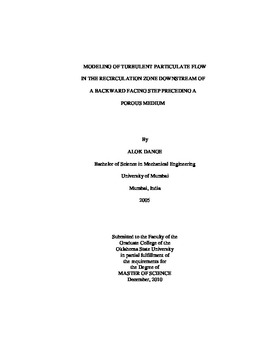| dc.contributor.advisor | Chambers, Frank W. | |
| dc.contributor.author | Dange, Alok | |
| dc.date.accessioned | 2014-04-17T19:52:12Z | |
| dc.date.available | 2014-04-17T19:52:12Z | |
| dc.date.issued | 2010-12-01 | |
| dc.identifier.uri | https://hdl.handle.net/11244/9915 | |
| dc.description.abstract | The current study focuses on flow characteristics and particle motion in the recirculation zone downstream of a backward facing step preceding a porous medium. A two dimensional backward facing step is created in ICEM CFD and the computations are performed in FLUENT. The numerical results for the velocity field are validated with the experimental results and with previous numerical results from the literature. A porous medium is placed at 4.25h and 6.75h from the step, where h is the step height, and its effect on the recirculation zone and the particle motion is analyzed. The Reynolds numbers used are 6550 and 10000. The k-epsilon RNG model with standard wall functions is used for modeling the continuous phase and the discrete phase is modeled using the discrete phase model of FLUENT. For the discrete phase, monodispersed particles of 10 microns and 40 microns diameter and polydispersed particles ranging from 1 micron to 50 microns, corresponding to the Stokes number ranging from 0.1 to 10 are used. The particle tracks are studied for the filter at 4.25h and 6.75h from the step. It is observed that the numerical results for velocity are in agreement with the experimental results and with previous numerical results from the literature, except for the velocity profiles at X = 3.75h when the filter is placed at 4.25h from the step. This may be due to the porous jump boundary condition used to model the filter. The recirculation zone is highly affected by the placement of the filter at 4.25h from the step. But when the filter is moved farther downstream at 6.75h, the effect on the recirculation zone is negligible. The discrete phase model tracks injected particles inside the domain and provides results which are qualitatively similar to the literature. It is observed that the particles with lower Stokes number, and thus lower momentum, tend to follow the flow and enter the recirculation zone and the particles with higher Stokes number tend to reach the filter directly without entering the recirculation zone. The location of the filter also plays a significant role. When the filter is moved farther downstream at 6.75h, the recirculation zone is increased which results in more particles entering the recirculation zone. The results for the monodispersed and the polydispersed particles agree. | |
| dc.format | application/pdf | |
| dc.language | en_US | |
| dc.publisher | Oklahoma State University | |
| dc.rights | Copyright is held by the author who has granted the Oklahoma State University Library the non-exclusive right to share this material in its institutional repository. Contact Digital Library Services at lib-dls@okstate.edu or 405-744-9161 for the permission policy on the use, reproduction or distribution of this material. | |
| dc.title | Modeling of Turbulent Particulate Flow in the Recirculation Zone Downstream of a Backward Facing Step Preceding a Porous Medium | |
| dc.type | text | |
| dc.contributor.committeeMember | Lilley, David G. | |
| dc.contributor.committeeMember | Sallam, Khaled A. | |
| osu.filename | Dange_okstate_0664M_11235.pdf | |
| osu.college | Engineering, Architecture, and Technology | |
| osu.accesstype | Open Access | |
| dc.description.department | Mechanical & Aerospace Engineering | |
| dc.type.genre | Thesis | |
| dc.subject.keywords | discrete phase modeling | |
